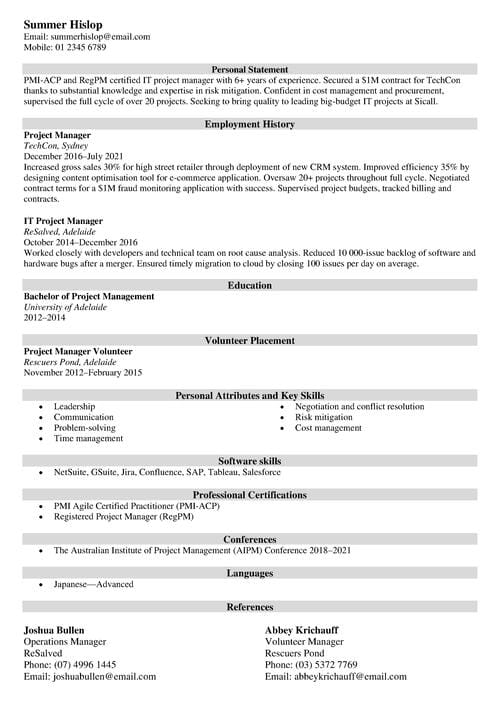


This is it. This is yours now or never—take our advice to heart and don’t worry about how to write a resume ever again.
So you sent out resumes, and the only thing you hear is crickets?
Crikey.
Even if you were stoked for that opportunity, you can’t miss another.
Check out how to write a resume that will make your phone buzz with interview invites. We’ve got you covered with heaps of advice.
You’ll get:
Want to save time and have your resume ready in 5 minutes? Try our resume builder. It’s fast and easy to use. Plus, you’ll get ready-made content to add with one click. See 20+ resume templates and create your resume here.


Sample resume made with our builder—See more resume examples here.
How to make a resume step by step:
Summer Hislop
Email: [email protected]
Mobile: 01 2345 6789
Personal Statement
PMI-ACP and RegPM certified IT project manager with 6+ years of experience. Secured a $1M contract for TechCon thanks to substantial knowledge and expertise in risk mitigation. Confident in cost management and procurement, supervised the full cycle of over 20 projects. Seeking to bring quality to leading big-budget IT projects at Sicall.
Employment History
Project Manager
TechCon, Sydney
December 2016–July 2021
Responsibilities and Achievements:
IT Project Manager
ReSalved, Adelaide
October 2014–December 2016
Responsibilities and Achievements:
Education
Bachelor of Project Management
University of Adelaide
2012–2014
Academic Achievements:
Volunteer Placement
Project Manager Volunteer
Rescuers Pond, Adelaide
November 2012–February 2015
Responsibilities and Achievements:
Personal Attributes and Key Skills
Software skills
Professional Certifications
Conferences
Languages
References
Joshua Bullen
Operations Manager
ReSalved
Phone: (07) 4996 1445
Email: [email protected]
Abbey Krichauff
Volunteer Manager
Rescuers Pond
Phone: (03) 5372 7769
Email: [email protected]
Now—
Find out how to write a professional resume:
Your mates popped by for a visit, and you said sorr-ee because the house looked like a dog’s breakfast.
They didn’t call, so everyone’s chill.
Well—
Your recruiter won’t relax reading your resume if you don’t care about a clean layout of your resume.
Follow these rules, and you’ll both end up just fine:
Don’t put words just yet!
Do you know the difference between reverse chronological and functional resume formats?
Exactly.
They exist to help your recruiter determine the level of experience you have. So, depending on where you are with your career, you should choose differently.
See which one is the right for you:
It’s the Acca Dacca of resume formats. Both Applicant Tracking Software (ATS) and recruiters love it.
The software parses resumes before recruiters lay their hands on them, and because ATS is familiar with such a format, it’s a safe bet.
Professional experience stands at the forefront in the chronological resume. When listing your work history, start with the most recent position.
See how to order your resume sections in the chronological resume:
Have you ever taken a photo where your mate went bonkers in the background and stole all the attention?
Defo.
In the functional resume, it’s the skills that photobomb your experience and shine through the resume. This format is useful to people with employment gaps, no real work experience, or changing their careers.
Have a look at the resume order in the functional resume:
And that’s it.
For the sake of this guide, let’s get down to filling in the sections one after another in a reverse-chronological format.
You scout. You sneak. But, eventually, you spook.
“How’s that possible?”
Resume headers aren’t the place to learn new job-hunting skills. Recruiters must know they’re dealing with a pro to catch the bait.
When you get to the header range, write only the necessary information:
You can mention your home address, but it’s not a requirement in most cases. It’s best to leave it off.
There are items you shouldn’t include due to legal reasons:
Now spot the below resume header example:
| RIGHT |
|---|
Summer Hislop Email: [email protected] Mobile: 0123 456 789 |
Nothing too complicated.
Just make sure to double-check if you wrote correct info, or else you’ll serve your prey on a tray.
The most dreaded assignment for every student out there—
“Say a few words about yourself to the class.”
Unless your face goes fair dinkum red, it’s your chance to make it big. Or a meme if you bail.
Sorry to disappoint—you can’t weasel out this time. Your resume personal statement is your elevator pitch.
Depending on how much experience you have, you choose either a career / personal summary or resume objective. Learn the difference between the two and find out how to write a personal statement for a resume:
A resume professional summary summarises your work experience, skills, and qualifications needed for the job. So, if you have enough work history to prove your skillset, this is your go-to.
Right under the resume header, write 3-4 short sentences that describe your career history. But—
Stay relevant!
You must tailor the summary to the job ad. See the requirements in the job description and refer to them. It’s a perfect place to drop a few achievements.
Use this resume summary template for your professional resume, and she’ll be apples:
[Adjective(s)/strong character trait(s)][your job title][your experience]. Eager to support/help/assist/etc. [company name][what you want to help the employer achieve and how you want to do it]. [your key achievement(s)].
Now check it out in practice:
| RIGHT |
|---|
PMI-ACP and RegPM certified IT project manager with 6+ years of experience. Secured a $1M contract for TechCon thanks to substantial knowledge and expertise in risk mitigation. Confident in cost management and procurement, supervised the full cycle of over 20 projects. Seeking to bring quality to leading big-budget IT projects at Sicall. |
| WRONG |
|---|
I have experience as an IT project manager that I would love to use for your company. I am experienced in cost management and procurement, and my daily tasks required skills in risk mitigation. The projects I led involved high budgets and tight deadlines. |
Ooh, the first one is a ripper.
Here’s why:
Now let’s see how to write a resume objective—
A resume career objective is ideal for students, career changers, or candidates applying for entry-level / junior positions.
It focuses on your skills, personality traits, and overall career goal. A good objective also includes how your skills will be beneficial to the employer.
Find a resume objective template below:
[Your strong trait(s)][position to which you’re applying for]. Seeking to support/gain/etc. [your offer][company name]. [2-3 skills].
See how it works in a real-life example:
| RIGHT |
|---|
Driven BS in Computer Science graduate with proven project management skills. Looking for an IT project manager position at Mice&Mozz to utilise communication and leadership skills to deliver results and success according to the company’s strategy. |
| WRONG |
|---|
Recent university graduate looking for an IT project manager position to build my skillset. |
Again—
The first one’s sick!
It describes transferable skills from the university, it’s tailored to the offer, and shows which abilities will be helpful to the company’s goals.
The other one, though… Why did Summer even bother to write it?
Pro Tip: Write your personal statement last. When you tailor your experience, education, and skill sections, you’ll only need to pick up the most significant achievements, and the statement’s ready.
When making a resume in our builder, drag & drop bullet points, skills, and auto-fill the boring stuff. Spell check? Check. Start building a professional resume template here for free.
When you’re done, Zety’s resume builder will score your resume and tell you exactly how to make it better.
Work experience is the substance of your resume.
Or, in simpler terms—
It’s the Vegemite on a Vegemite sandwich.
So to prove you speak-a the language of the offer, make sure you include all the following in your work history section:
Also—
Don’t go back more than 10 years unless you’re applying for a senior position and the earlier jobs are still highly relevant. In that case, 15 years is your threshold.
| RIGHT |
|---|
Project Manager TechCon, Sydney December 2016–July 2021 Responsibilities and Achievements:
|
| WRONG |
|---|
TechCon 12/2016–Current
|
The first example proves Summer took our advice to heart.
She listed contributions and achievements instead of responsibilities, there are quantifiers that draw attention and bring out the accomplishments, and the formatting is sweet as. Plus, she’s consistent with what she wrote in her personal statement.
Ace!
Pro Tip: Unpaid gigs can be relevant to the job, too. If you did any work placement, TAFE, or volunteered, include that as well.
The education section is a two-way crossroad with no wrong turns.
Finally. Something easy.
The traffic regulations are:
You can list academic achievements, e.g., awards, honours, grade if you achieved a Distinction or High Distinction, or making the Dean’s list. You can also include extracurriculars, like memberships, affiliations, project groups, volunteer placements, or publications.
The educational background, like every other section in the resume, is about relevancy. If you decide to add coursework or describe a project assignment, it has to show the skills that’ll come in handy for the position.
| RIGHT |
|---|
Bachelor of Project Management University of Adelaide 2012–2014 Academic Achievements:
|
| WRONG |
|---|
Project Management, 2014 Adelaide University |
That’s pure gold.
You don’t have to say that you have project management skills explicitly. Being shortlisted for a global award is self-evident.
Which marking colour have you seen most often in your school workbooks? Let’s hope your resume will, too, show green in the ATS.
Why?
Skills are yet another section you need to tailor to the job offer. Find various skill keywords when browsing the job description and list them in your resume.
But add the skills you really have! Lying never pays off.
There are two types of skills you should consider mixing: soft and hard skills.
Soft skills speak about personal attributes, like communication, critical thinking, or decision-making skills. You can fit them under the “Key skills” section. Personal attributes are helpful when you’re applying for a junior position. They’ll demonstrate whether you’re the perfect fit.
Hard skills describe your knowledge to perform specific jobs, for example, programming for developers or tax law for payroll specialists. Depending on what you want to group, these tend to have a separate section in resumes, such as “Programming languages” or “Software skills.”
Here’s a list of common employability skills to add to a resume:
There are plenty of situations where you displayed your skillset. You don’t have to limit yourself to work experience only. Think about the school, university, work placement, or volunteering, too.
Take a look at the below resume sample:
| RIGHT |
|---|
Key skills
Software skills
|
Summer wasn’t faffing around!
It looks like she matched her skills perfectly to the IT project manager position and proved she applied them in her regular job.
Apart from the skills—
Perfect resumes come in bundles of mandatory and additional sections.
You’ve already done a great job putting your must-haves in the trolley. But if you take some extras, you can not only pick up a bargain, but also a top up your voucher for a job interview.
See which additional resume sections are worth considering:
Now see how to add other sections to your resume:
| RIGHT |
|---|
Volunteer Placement
Project Manager Volunteer Rescuers Pond, Adelaide November 2012–February 2015 Responsibilities and Achievements:
Professional Certifications
Conferences
Languages
|
Employers don't like being played. And they have their ways not to let that happen.
At the end of your resume, you should always include the contact details of two referees who aren't your relatives.
Recruiters contact them to see whether they recommend you as an employee.
Cool, huh?
Once you decide who that can be, remember to ask if they agree to it and whether they're OK with listing their contact details. If they don't choose to do that, write “References available on request” instead.
See how to add contact details to your referees in the resume:
| RIGHT |
|---|
References
Joshua Bullen Operations Manager ReSalved Phone: (07) 4996 1445 Email: [email protected]
Abbey Krichauff Volunteer Manager Rescuers Pond Phone: (03) 5372 7769 Email: [email protected] |
Think hard when choosing your referee for a resume. You want to be sure that the person that sends a reference letter for you is trustworthy and will say positive things about you.
Now onto the chapter you’ve probably never seen coming—
Far, far away, there lived an evil fairy.
She told every job seeker not to write a cover letter or else they’ll be cursed with a wasted arvo and jobless life. Little did they know that she was the Queen of Lies…
The truth is, recruiters ignore job applications without cover letters.
Why don’t you stop believing the wicked fairy and just get down to work?
The more personal the cover letter is, the better. This is your chance to allow the recruiters to get to know you and pick up your character.
Give them the best you’ve got.
Plus, a great cover letter that matches your resume will give you an advantage over other candidates. You can write it in our cover letter builder here. Here's what it may look like:
See more cover letter templates and start writing.
Everything you need to know about how to write a resume in a nutshell:
And that’s a wrap.
Chookas!
Please tell us—
Do you have questions about how to write a resume? Did we miss any resume writing tips? What do you think of attaching a cover letter to your job application?
Give us a shout in the comments! Let’s get the conversation rolling.
This is it. This is yours now or never—take our advice to heart and don’t worry about how to write a resume ever again.
CV, resume, cover letter… It’s all too easy to get confused when applying for jobs. Time to sort it out once and for all: what is a CV, and is it different from a resume?
Is it the email you write when sending your resume to a recruiter? Is it a thing of the past? What is a cover letter and what’s it for? Time to find out!


